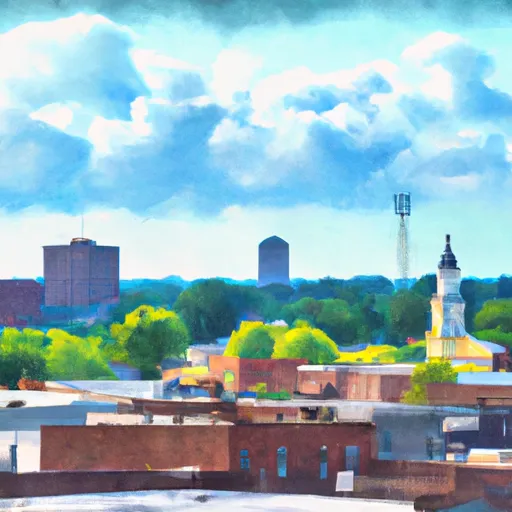-
 Snoflo Premium
Snoflo Premium
Get unlimited access to all our content
With no Ad interruptions! - Start Your Free Trial Login with existing account
North-Salem
Eden Index
Climate
8.0
•
Recreation
2.8
•
Community
0.9
•
Safeguard
4.4/10

North Salem, Indiana, is a small town located in Hendricks County. The climate in North Salem is classified as humid continental, characterized by warm summers and cold winters. The area experiences an average temperature of 54°F and receives about 41 inches of rainfall annually.
North Salem is situated near several bodies of water, including Thorn Creek, which flows through the town. This hydrological feature provides scenic views and recreational opportunities such as fishing, canoeing, and kayaking.
Additionally, North Salem is surrounded by picturesque landscapes, making it an ideal destination for outdoor enthusiasts. The town offers various outdoor recreation opportunities, including hiking and biking trails, camping areas, and parks. Visitors can explore the natural beauty of the area, enjoying activities such as birdwatching, picnicking, and nature walks.
What is the Eden Index?
The Snoflo Eden Index serves as a comprehensive rating system for regions, evaluating their desirability through a holistic assessment of climate health, outdoor recreation opportunities, and natural disaster risk, acknowledging the profound impact of these factors on livability and well-being.
Climate Health Indicator (CHI): 8.0
North-Salem receives approximately
1083mm of rain per year,
with humidity levels near 82%
and air temperatures averaging around
11°C.
North-Salem has a plant hardyness factor of
5, meaning
plants and agriculture in this region thrive during a short period during spring and early summer. Most
plants will die off during the colder winter months.
By considering the ideal temperature range, reliable water supplies, clean air, and stable seasonal rain or snowpacks, the Climate Health Indicator (CHI) underscores the significance of a healthy climate as the foundation for quality living.
A healthy climate is paramount for ensuring a high quality of life and livability in a region, fostering both physical well-being and environmental harmony. This can be characterized by ideal temperatures, reliable access to water supplies, clean air, and consistent seasonal rain or snowpacks.
Weather Forecast
Streamflow Conditions
Patoka-White
Area Rivers
Patoka-White
Snowpack Depths
Patoka-White
Reservoir Storage Capacity
Patoka-White
Groundwater Levels
Recreational Opportunity Index (ROI): 2.8
The Recreational Opportunity Index (ROI) recognizes the value of outdoor recreational options, such as parks, hiking trails, camping sites, and fishing spots, while acknowledging that climate plays a pivotal role in ensuring the comfort and consistency of these experiences.
Access to outdoor recreational opportunities, encompassing activities such as parks, hiking, camping, and fishing, is crucial for overall well-being, and the climate plays a pivotal role in enabling and enhancing these experiences, ensuring that individuals can engage in nature-based activities comfortably and consistently.
Camping Areas
| Campground | Campsites | Reservations | Toilets | Showers | Elevation |
|---|---|---|---|---|---|
| Newton Stewart State Rec Area - Patoka Lake | 500 | 728 ft | |||
| Sycamore Springs Park | None | 490 ft | |||
| Crane MWR Military | None | 594 ft | |||
| Hardin Ridge | 200 | 780 ft | |||
| Martin State Forest | 25 | 743 ft | |||
| Cedar Creek - Old Hickory Lake | 60 | 459 ft | |||
| Cages Bend - Old Hickory Lake | 43 | 477 ft | |||
| Paynetown State Rec Area - Monroe Lake | 320 | 557 ft | |||
| Ferdinand State Forest | 70 | 489 ft | |||
| Springs Valley Rec Area | 10 | 672 ft |
Nearby Ski Areas
Catastrophe Safeguard Index (CSI):
The Catastrophe Safeguard Index (CSI) recognizes that natural disaster risk, encompassing floods, fires, hurricanes, and tornadoes, can drastically affect safety and the overall appeal of an area.
The level of natural disaster risk in a region significantly affects safety and the overall livability, with climate change amplifying these risks by potentially increasing the frequency and intensity of events like floods, fires, hurricanes, and tornadoes, thereby posing substantial challenges to community resilience and well-being.
Community Resilience Indicator (CRI): 0.9
The Community Resilience Indicator (CRI) recognizes that education, healthcare, and socioeconomics are crucial to the well-being of a region. The CRI acknowledges the profound impact of these elements on residents' overall quality of life. By evaluating educational resources, healthcare accessibility, and economic inclusivity, the index captures the essential aspects that contribute to a thriving community, fostering resident satisfaction, equity, and social cohesion.

